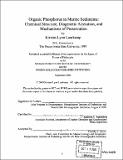| dc.contributor.advisor | Kathleen C. Ruttenberg. | en_US |
| dc.contributor.author | Laarkamp, Kirsten Lynn | en_US |
| dc.contributor.other | Woods Hole Oceanographic Institution. | en_US |
| dc.coverage.spatial | n-us-ca | en_US |
| dc.date.accessioned | 2007-10-22T19:52:28Z | |
| dc.date.available | 2007-10-22T19:52:28Z | |
| dc.date.issued | 2000 | en_US |
| dc.identifier.uri | http://hdl.handle.net/1721.1/39409 | |
| dc.description | Thesis (Ph.D.)--Joint Program in Oceanography (Massachusetts Institute of Technology, Dept. of Earth, Atmospheric, and Planetary Sciences and the Woods Hole Oceanographic Institution), 2000. | en_US |
| dc.description | Vita. | en_US |
| dc.description | Includes bibliographical references (leaves 266-286). | en_US |
| dc.description.abstract | Phosphorus, an essential nutrient, is removed from the oceans only through burial with marine sediments. Organic phosphorus (Prog) constitutes an important fraction (ca. 25%) of total-P in marine sediments. However, given the inherent lability of primary Prog biochemicals, it is a puzzle that any Porg is preserved in marine sediments. The goal of this thesis was to address this apparent paradox by linking bulk and molecular-level Porg information. A newly-developed sequential extraction method, which isolates sedimentary Pol reservoirs based on solubility, was used in concert with Prog nuclear magnetic resonance spectroscopy (31P-NMR) to quantify Prog functional group concentrations. The coupled extraction/ 31P-NMR method was applied to three sediment cores from the Santa Barbara Basin, and the first-ever high-resolution depth profiles of molecular-level Porg distribution during diagenesis were generated. These depth profiles were used to consider regulation of Prog distribution by biomass abundance, chemical structure, and physical protection mechanisms. Biomass cannot account for more than a few percent of sedimentary Prog. No evidence for direct structural control on remineralization of Porg was found. Instead, sorptive protection appears to be an important mechanism for Prog preservation, and structure may act as a secondary control due to preferential sorption of specific Porg compound classes. | en_US |
| dc.description.statementofresponsibility | by Kirsten Lynn Laarkamp. | en_US |
| dc.format.extent | 286 leaves | en_US |
| dc.language.iso | eng | en_US |
| dc.publisher | Massachusetts Institute of Technology | en_US |
| dc.rights | M.I.T. theses are protected by copyright. They may be viewed from this source for any purpose, but reproduction or distribution in any format is prohibited without written permission. See provided URL for inquiries about permission. | en_US |
| dc.rights.uri | http://dspace.mit.edu/handle/1721.1/7582 | |
| dc.subject | Joint Program in Oceanography. | en_US |
| dc.subject | Earth, Atmospheric, and Planetary Sciences. | en_US |
| dc.subject | Woods Hole Oceanographic Institution. | en_US |
| dc.subject.lcsh | Marine sediments California Santa Barbara Basin | en_US |
| dc.subject.lcsh | Phosphorus Structure | en_US |
| dc.subject.lcsh | Diagenesis | en_US |
| dc.subject.lcsh | Chemical oceanography California Santa Barbara Basin | en_US |
| dc.title | Organic phosphorus in marine sediments : chemical structure, diagenetic alteration, and mechanisms of preservation | en_US |
| dc.type | Thesis | en_US |
| dc.description.degree | Ph.D. | en_US |
| dc.contributor.department | Joint Program in Oceanography | en_US |
| dc.contributor.department | Woods Hole Oceanographic Institution | en_US |
| dc.contributor.department | Massachusetts Institute of Technology. Department of Earth, Atmospheric, and Planetary Sciences | |
| dc.identifier.oclc | 48686957 | en_US |
